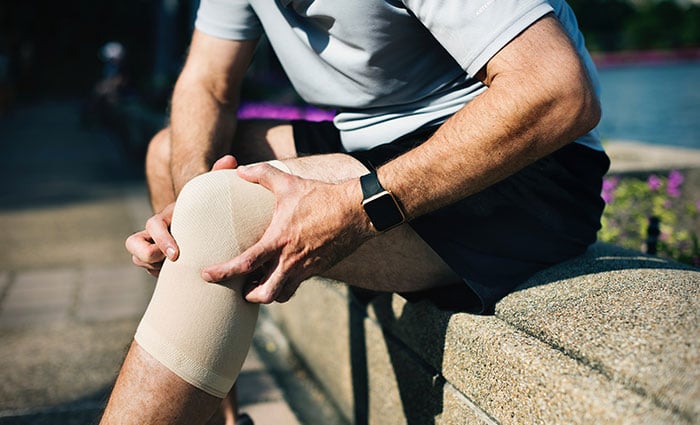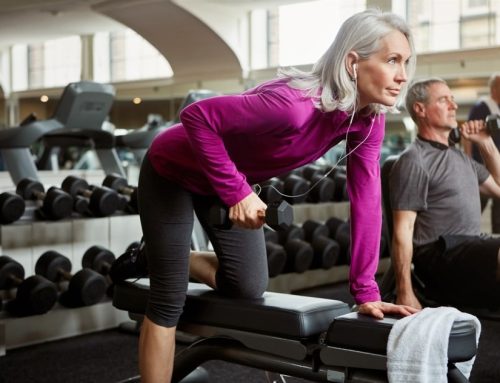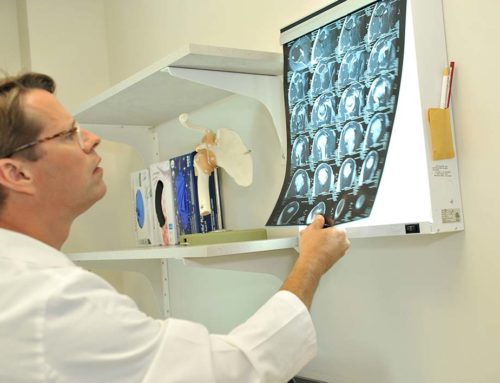The knee is the largest joint in the body. With its multiple bones, discs, ligaments, tendons and muscles, there are a lot of moving parts! These parts help the knee absorb the shock of walking, running, jumping and other daily activities. When someone experiences knee pain, it can impact their ability to get dressed, use the restroom, use the stairs in their home and more.
The knee’s many moving parts make it susceptible to injury. Knee pain and injury are the second most common orthopaedic condition, prevalent in nearly half the U.S. population.
Knee pain can begin in children and teens experiencing rapid growth spurts or overuse injuries from sports and physical activities. Other common knee injuries include sprains and breaks as well as tears of the anterior cruciate ligament (ACL) and meniscus. About a quarter of American adults over age 55 have constant knee pain, often due to osteoarthritis or the wearing away of knee cartilage.
Fortunately, there are many ways to postpone problems or even prevent knee injuries entirely. These tips from the doctors at Cary Orthopaedics can help you maintain healthy knees and delay or avoid the need for surgical intervention.
Strengthen your muscles
Strengthening the muscles around your knees makes a big difference! Strong leg muscles:
- Give the joints support
- Improve the range of motion
- Protect cartilage, tendons and ligaments in the knee
- Lower the amount of stress placed on the knee joint
- Improve balance and stability, lowering the risk of falls
Strength training is especially important for healthy knees because, beginning at age 30, adults gradually lose muscle mass and function. This normal part of aging is called sarcopenia. Average adults lose about three to five percent of muscle each decade.
To avoid or relieve knee pain, focus on strengthening the muscles around your kneecaps, hips and pelvis. These include the quadriceps, hamstrings, hip abductors and calves. A strong core is also essential when promoting knee health. Making these muscles stronger will absorb some of the stress on your knees, allowing them to stay balanced and stable.
Choosing the proper strength training exercises is key. If you already experience joint problems, avoid quick, repetitive movements. If you’re unsure what strengthening exercises to do, a physical therapist can show you specifics to address certain areas and how to do them correctly.
Get moving
Movement is vital to maintaining joint health, especially in the knees. The more you move, the less stiffness you’ll experience. The Centers for Disease Control (CDC) recommends that adults be physically active for at least 30 minutes five times a week.
Moving also means taking frequent breaks from sedentary positions, whether reading, watching TV or sitting at a computer. If you have a smartwatch, you can set reminders to stand up and move around. These reminders help your knees and joints remain healthy. Take time to get up from your chair or desk at work and be active throughout the day.
Low-impact exercise can be a good option for sensitive joints. Activities such as walking, swimming, water aerobics and bicycling can help decrease joint stiffness in your knees while building muscle. Cary Orthopaedic staff recommend water workouts because they relieve pressure on the joints and provide resistance that strengthens muscles.
When walking, choose flat surfaces and avoid activities that put extra stress on your knees, such as downhill running or deep knee bends.
Proper running can be a good option for knee health, too. An analysis of 17 studies found that recreational runners have a lower risk of developing osteoarthritis than non-runners and competitive runners.
Maintain a healthy weight
More than 40 percent of U.S. adults are considered obese. Being overweight causes significant stress on the knees and other joints. Obesity increases the likelihood of joint pain and damage. It also increases your risk of developing and aggravating osteoarthritis.
To quantify the amount of pressure placed on the knee joints by excess weight, consider this: For every pound a person loses, four pounds of pressure are relieved off his or her knees! This means that being 20 pounds overweight adds 80 pounds of pressure on your knees.
This added pressure also increases the strain on your hips and back, potentially causing pain in these areas as well.
Eating healthfully, exercising, strength training and losing weight can help reduce pain. Studies have shown that losing as little as 10 pounds can decrease the progression of osteoarthritis in the knee by 50 percent. Maintaining a body mass index (BMI) in a healthy range will make your knees feel better and reduce the risk of injury.
Keep your bones strong
Strong, healthy bones create the framework for our bodies, protect our organs and enable our activity and movement. As men and women age, their bones lose mass and strength due to a decline in the body’s bone-rebuilding process. Bone density loss can lead to a range of issues, including knee problems due to osteoarthritis in older adults.
To help strengthen bones and lower the threat of pain or injury, be sure you are getting enough calcium. Drinking milk is an obvious way to obtain calcium, but don’t forget about these calcium-rich foods to preserve healthy knees:
- Calcium-rich dairy like yogurt and cottage cheese
- Green, leafy vegetables like kale, broccoli, spinach and collard greens
- Nuts and seeds like almonds, chia seeds and flaxseeds
- Dried fruits like figs or prunes – a recent study found eating five or six prunes a day helped older women preserve bone density
- White beans like navy, cannellini, great northern or lima beans
- Canned salmon
- Fortified foods
Applying a small amount of pressure on your bones through low-to-medium impact exercise has also been shown to keep bones strong. Brisk walking, jogging, aerobic exercises and strength training all help strengthen bones.
Increase range of motion
Most people’s joints grow stiffer with age. To help avoid knee stiffness, focus on maintaining a good range of motion in your knee joints.
People with a full range of motion often have fewer issues with knee pain, especially if they can fully straighten their knees. Work on getting your knee straight by sitting on the floor or bed, placing a pillow under your ankle, and using your leg muscles to press your knee down gently without applying too much pressure and causing pain.
Make stretching part of your routine
Stretching helps to maintain a well-conditioned, flexible body. It also helps to reduce injuries and improve balance.
Focus on stretches that you feel in the hamstring, calf and quadricep muscles to take pressure off the kneecaps and knees. Step-ups, straight-leg lifts and hamstring curls are good exercises to help protect the knees.
Also, incorporate stretches that improve flexibility in the hips, such as a butterfly stretch, to help alleviate knee pain.
Wear appropriate shoes
Supportive, comfortable shoes can contribute to healthy knees by keeping joints aligned. Choose the proper footwear for the activity (i.e., wear hiking shoes to go on a hike) and limit high-heel usage.
Treat knee pain and injuries
Joint injuries can add to the breakdown of cartilage in your joints. If you experience an injury, see your doctor right away for treatment. By taking immediate steps to seek treatment, you can avoid further damage and pain.
Despite your best efforts in making healthy decisions for your knees, overuse injuries and wear and tear on joints and muscles can still occur. Listen to your body. Rest, ice or heat injuries according to your orthopaedic doctor’s orders.
If you experience chronic or acute knee pain, the physicians at Cary Orthopaedics are here to help. We provide comprehensive orthopedic and spine care at locations across Wake County. Our specialists can recommend the best course of treatment for healthy knees.






